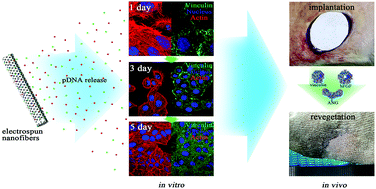A gene-activating skin substitute comprising PLLA/POSS nanofibers and plasmid DNA encoding ANG and bFGF promotes in vivo revascularization and epidermalization†
Abstract
Vascularization of deep skin defects is a key challenge for the healing of tissue with blood vessel structures. In this research, to accelerate wound regeneration, complexes of trimethyl chitosan chloride (TMC) and multiple plasmid DNAs (pDNAs) encoding angiopoietin (ANG) and basic fibroblast growth factor (bFGF) were integrated into porous nanofibers of poly(L-lactic acid) (PLLA)/polyhedral oligomeric silsesquioxane (POSS); these nanofibers were used to treat deep skin defects. The pDNAs were stably released in a sustained manner from the PLLA/POSS porous nanofibrous scaffold. The PLLA/POSS/pDNA nanofibers showed a notable positive influence on the transfection of human umbilical vein endothelial cells (HUVECs) in vitro, and the PLLA/POSS/pANG/pbFGF (Fab) composite nanofibers showed a significantly higher expression of ANG and vinculin than the nanofibers without pDNA or the nanofibers loaded with only pANG or pbFGF. The four different composite nanofibers were further transplanted onto deep burn wounds on the backs of rats in vivo. The results indicated that the Fab nanofibers had observably higher neovasculature regeneration. This finding revealed that Fab not only prevented the inflammatory response but also accelerated wound regeneration. All of the results showed that pANG and pbFGF exhibited positive effects in promoting tissue repair. In particular, bFGF can guide perithelial cells to form a cellular layer around new capillaries, ensuring vascular maturation and preventing vascular degradation. Therefore, an even higher level of vascularization can be realized when ANG and bFGF are both present to achieve desirable interactions for wound repair.



 Please wait while we load your content...
Please wait while we load your content...